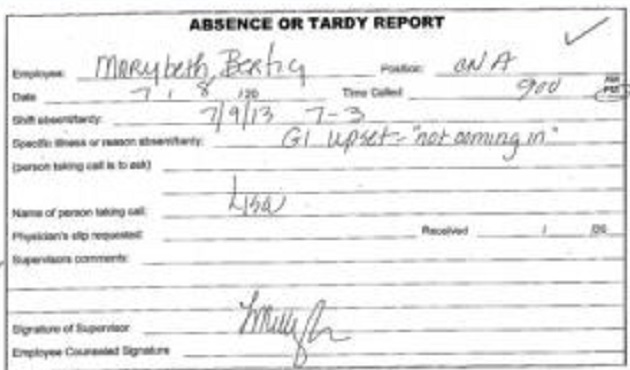Viewpoint: Firing an Employee with FMLA Leave and Unexcused Absences
A court rules that FMLA leave didn't prevent a lawful termination

Here's a puzzle for you. How would you handle it?
Mary Beth is a nurse for a local hospital and has been diagnosed with cancer and asthma. Over the course of about one year:
- She is certified for Family and Medical Leave Act (FMLA) leave for her cancer and asthma.
- She incurs a total of 13 intermittent absences in a 12-month period.
- A handful of these absences relate to her cancer and asthma.
- Plenty more absences are for various other reasons, including foot pain, a stress fracture in her foot, sore throat, dizziness, common cold, stomach cramps, an upset GI, and diarrhea.
Sheesh! Some of this stuff is Too Much Information.
Under the hospital's policies, employees are subject to termination when they accrue seven absences in a rolling 12-month period. When Mary Beth reached this grand milestone (and then some), the hospital terminated her employment.
But what about the FMLA absences? Can Mary Beth lawfully be terminated for the non-FMLA absences even though others are FMLA-related?
Many employers are paralyzed by this situation. Among other things, they are concerned that: 1) the employee cannot be terminated because it comes during a time period when the employee is using FMLA leave; or 2) the employee will claim after-the-fact that they reported an FMLA-reason for some or all of the absences and that they should not have been considered for the termination.
[SHRM members-only HR forms: FMLA Notice of Eligibility and Rights & Responsibilities (Form WH-381)]
The Ruling
In Mary Beth's situation, she was properly terminated, and the court said so. The U.S. district court for the middle district of Pennsylvania summed up its reasoning quite simply:
Plaintiff was entitled to take leave for [cancer and asthma] under the FMLA, as she had done in 2012 for a brief time period. However, by plaintiff's own admission, most of her absences between April 2013 and April 2014 were unrelated to her asthma and were unrelated to her bladder cancer ... FMLA qualified absences aside, plaintiff still missed ten days of work for miscellaneous reasons—three absences more than allowed by defendants prior to termination. (Bertig v. Julia Ribaudo Healthcare Group)
As the court pointed out, by Mary Beth's own admission, most of her absences during the time period identified by the employer were unrelated to her asthma and bladder cancer, so they could not have been protected by the FMLA.
Insights for Employers
The court's decision to dismiss Mary Beth's FMLA claims was made easy because the employer did a fabulous job documenting all of Mary Beth's absences. If employers want the same level of success, two steps are critical:
• Document each absence.
The hospital documented each absence and the reasons for the absence on an "Absence or Tardy" report, as shown below (from evidence provided to the court).
In this report, the employee's supervisor documented the reason for each absence/tardy along with additional details about the absence. These reports later are golden when the employer is considering termination, as we now have an actual document explaining why an employee was absent on a particular occasion.
It takes some work, of course, but it's highly effective. Let's face it: Some of you "log" all your call-ins for in some book or the back of a napkin that never sees the light of day.
Work with your employment counsel to construct a system for logging calls which sufficient information about the absence and a review by an HR or a leave administrator so that the employer follows up with the employee on potential FMLA-related absences.
• Audit absences at the time of termination.Before you hit the termination button on an employee due to attendance issues, conduct an audit of all the absences serving as the basis for the termination decision and confirm with documentation (see your new logging system, above) that none of these absences could have been covered by the FMLA or Americans with Disabilities Act (ADA). If there is any doubt about whether one or more days could have been covered by FMLA, ask the employee about the absence.
• Don't forget progressive discipline and the interactive process.
As Mary Beth accrues unexcused absences, are you talking to her about your attendance expectations and how she is falling short? Are you also using it as an opportunity to ask her if there is anything you can do to help her meet your expectations?
Unfortunately, some employers seek legal advice well down the road in this process and they have not had sufficient dialogue with the employee to set expectations and offer assistance.
Engaging in progressive discipline and showing that you did all you could to help the employee succeed leading up to termination adds yet another strong layer to guard against an FMLA or ADA claim.
Jeff Nowak is a shareholder at Littler, an employment and labor law practice representing management, and author of the FMLA Insights blog, where this article originally appeared. © 2017 Jeff Nowak. All rights reserved. Republished with permission.
Related SHRM Articles:
Train Your Managers on the FMLA, or You're Courting Trouble, SHRM Online Benefits, November 2017
Court Decisions Scale Back Additional Leave After FMLA Is Exhausted, SHRM Online Benefits, October 2017
Employee Who Did Not Respond to Employer Loses ADA, FMLA Claims,SHRM Online Employment Law, October 2017
Let Employees Alone During FMLA Time Off, SHRM Online Employment Law, October 2017
If an Employee Attends a Beyonce Concert While on FMLA Leave, Can She Be Terminated?, SHRM Online Benefits, September 2017
An organization run by AI is not a futuristic concept. Such technology is already a part of many workplaces and will continue to shape the labor market and HR. Here's how employers and employees can successfully manage generative AI and other AI-powered systems.




